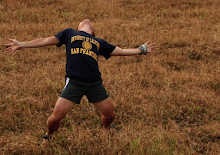Couscous or kuskus as it is known in Morocco, Algeria, Tunisia, Egypt and Libya (pronounced /ˈkuːskuːs/ in the US, /ˈkʊskʊs/ in the UK; Berber Seksu - Arabic: كسكس, called maftoul in Lebanon and the Palestinian territories) is a dish consisting of spherical granules made by rolling and shaping moistened semolina wheat and then coating them with finely ground wheat flour. The finished grains are about 1 mm in diameter before cooking. The Levantine variant often misquoted as Israeli, is about twice the diameter and made of hard wheat instead of semolina.[2] Traditional couscous requires considerable preparation time and is usually steamed. In many places, a more processed quick-cook couscous is available and is particularly valued for its short preparation time.
The dish is a primary staple throughout the Maghreb;[3] in much of Morocco, Algeria, Tunisia, and Libya it is also known as ṭa`aam طعام, "food".[citation needed] It is also popular in the West African Sahel, in France, Madeira island, in western Sicily's Trapani province, and parts of the Middle East. It is particularly popular among Jews of North African descent, such as the Berber Jews,[4] and is eaten in many other parts of the world as well.
Couscous is traditionally served under a meat or vegetable stew. It can also be eaten alone flavoured or plain, warm or cold, as a dessert or a side dish.
Properly cooked Couscous should be light and fluffy, not gummy or gritty; steam Couscous two to three times to achieve this consistency.[citation needed] Traditionally, North Africans use a steamer called a kiskas in Arabic or couscoussière in French. The base is a tall metal pot shaped rather like an oil jar in which the meat and vegetables are cooked in a stew. On top of the base a steamer sits where the couscous is cooked, absorbing the flavours from the stew. The lid to the steamer has holes around its edge so that steam can escape. It is also possible to use a pot with a steamer insert. If the holes are too big the steamer can be lined with damp cheesecloth. There is little archaeological evidence of early diets including couscous, possibly because the original couscoussière was probably made from organic materials which could not survive extended exposure to the elements.








0 意見:
張貼留言